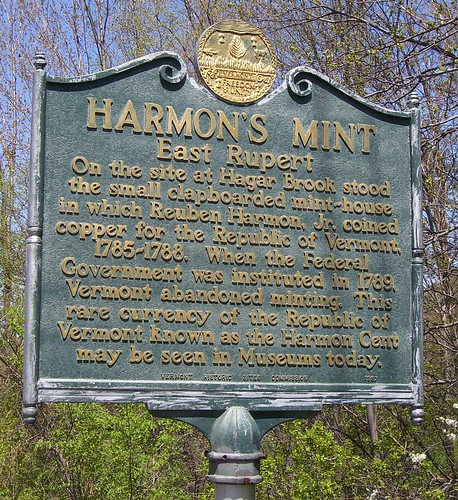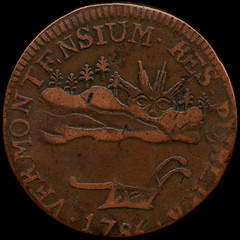
PREV ARTICLE
NEXT ARTICLE
FULL ISSUE
PREV FULL ISSUE
HISTORICAL MARKERS AND NUMISMATIC HISTORY
An interesting discussion in the Colonial Numismatics yahoo group was kicked off by a chance encounter with an historical marker alongside a road. It led me to a web page written by Rob Retz about 1997 relating a numismatic excursion in Vermont in 1994. Here's an excerpt. It's a great account of a numismatic road trip. I added an image of a Vermont copper from the site of today's Featured Web Page.
-Editor

Gene Kosche, the gracious retired curator of history at the Bennington Museum, arranged for us to view the collection and take notes and then casually dropped a bombshell on use. "Have you folks been over to see the mint building?" Three dumbfounded stares answered his question and a few minutes later one of us recovered our senses enough to blurt out that all accounts of the building indicated that it had been destroyed in a storm nearly 150 years ago. "Nah, it's over on Bob Graf's farm – everyone ‘round here knows about it. You really ought to see it." Talk about waving a red flag in front of some copper bulls! Early the next day, with plenty of sunlight to help, we headed north out of Bennington. About half an hour later we passed through the town of Dorset on Highway 30. This is the "main road leading from Dorset to Pawlet" mentioned in Crosby, and appears to follow roughly the same path as it did two centuries ago. Just north of Dorset we crossed over the Pawlet River. We were on Reuben Harmon's home turf, and we were getting close. About half a mile further we crossed a small creek and struck paydirt. This is the "small stream of water called Millbrook" that Harmon used to power his rolling mill. Continuing towards Pawlet we passed the Graf place, called Southwind Farm, made a quick U-turn and pulled into the driveway. Bob Graf was out of town, but his son-in-law was mowing the lawn and came over to talk to us. We asked about the mint building and with a hearty laugh he said "You want to see old Harmon's mint? It's right over here." He led us to a small garage just off the main driveway and said "You guys look around all you want. I've got to finish the yard, so just turn out the light when you're done." The building itself looked promising. While the roof and siding were old they certainly weren't more than three or four decades in age, and the cement floor was probably not what Reuben Harmon would have put in. The frame of the building, however, was of a much earlier vintage – rough hewn and assembled by mortise and tenon – and almost certainly late 18th Century. We paced out the size of the building, figuring it at roughly 16 by 20 feet, a pretty close match to Crosby's description of "about 16 by 18 feet." The age, size, and structure of the building fit what we knew about the mint, and local lore has ascribed it as the mint building for at least the last century, usually with that special New England flair that mixes pride for their history and extreme surprise that anyone else should care. We spent about two hours searching the area with a metal detector, hoping to locate at least a few landscape Vermonts (or an original die or two!), but only came up with a few broken bits of pottery and a rusted metal ring about two inches in diameter, probably from some type of horse's tack. As the sun was beginning to set we headed south back towards Bennington. Looking up at the mountains we all realized that the landscape Vermonts are not the stylized depiction that collectors assume them to be, but are rather a pretty accurate picture of the view from Reuben Harmon's own land. Gazing up at their majestic beauty, it was easy to understand why the Green Mountain Boys emerged over two centuries ago and fought for their property. In the end, we all agreed that everything looked right: if we were going to plan a mint, the building on Bob Graf's farm would have been perfect for the job, and we would have chosen the place at the mouth of the canyon where Millbrook descended from the mountains. We also began to wonder if Sylvester Crosby ever spent a sunny weekend afternoon wading up a river!
The reference is: Retz, Rob; Rock, Jeff; and Thies, Dick. In Search Of… Reuben Harmon's Vermont Mint and the Original Mint Site. The Colonial Newsletter. September, 1996. Volume 36 Number 3. pp. 1655-1658. Reprinted by permission of the authors, bless ‘em, and the Colonial Newsletter Foundation. For more information, see today's Featured Web Page.
To read the complete article, see:
VERMONT VACATIONING
(www.alfirin.net/wcc/wcc97jan.html)
The Numismatic Bibliomania Society is a non-profit organization promoting numismatic literature. See our web site at coinbooks.org. To submit items for publication in The E-Sylum, write to the Editor at this address: whomren@gmail.com To subscribe go to: https://my.binhost.com/lists/listinfo/esylum All Rights Reserved. NBS Home Page Contact the NBS webmaster 
|
